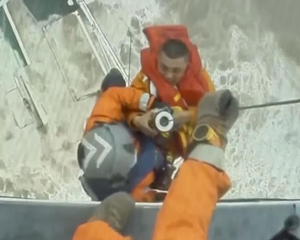Powerful waves triggered by Typhoon Chaba snapped the 200-meter-long "Fujing 001" in two when it was about 300 kilometers southwest of Hong Kong at around 7:30 A.M.
上午7时30分左右,在香港西南约300公里的位置,台风“暹芭”引发的强烈海浪,将船身200米长的“福景001号”拦腰折断。
The disaster happened near the eye of the typhoon when it was moving at a speed of 144 kilometers per hour, and churning 10-meter-high waves.
事故发生在台风风眼附近,当时台风“暹芭”正以每小时144公里的速度移动,并掀起了高达10米的巨浪。
Thirty sailors abandoned the engineering vessel when it broke up.
当工程船“福景001号”解体后,船上30名船员弃船逃生。
Hong Kong's Government Flying Service, or GFS, deployed a number of fixed-wing aircraft and helicopters to rescue the crew.
香港特区政府飞行服务队(GFS)随即出动多架固定翼飞机和直升机,营救船员。
A rescue ship from the mainland also joined in the operation.

By the time the Hong Kong aircraft arrived at the scene, half of the vessel had already sunk.
在香港的飞机到达现场时,船体的一半已经沉没。
Officers abseiled down the helicopter to rescue the crewmen, and as of 3:00 P.M., three had been winched to safety.
飞行员们从直升机上沿绳滑下营救船员,截至下午3点,共有3名船员被吊起送到安全的地方。
The survivors fear that the other crew members might have been swept away by the waves.
幸存者们担心其他船员很可能被海浪卷走了。
In a social media post, the GFS said adverse weather conditions brought on by Typhoon Chaba had made the rescue operation very difficult.
香港特区政府飞行服务队在社交媒体上发帖称,台风“暹芭”造成的恶劣天气条件,使得救援行动非常困难。
Controller West Wu told i-Cable News that metal fatigue could have led to the crack on the ship.
总监West Wu在接受有线电视新闻台采访时表示,金属疲劳可能是导致船体出现裂缝的原因。
Wu added that some structures, such as wind turbines, near the accident's site, made their efforts much more dangerous.
Wu还表示,事故现场附近的一些装置,如风力涡轮机,使他们的救援工作更加危险。












